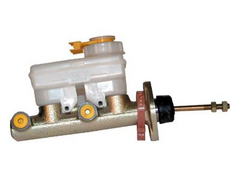whitestu
|
| posted on 2/7/08 at 12:54 PM |

|
|
Ferodo DS2500 pads
I was looking for some better pads in the Indy to give a bit more bite to the front brakes - just using Halfords standard pads at the mo, and
Burton's recommend these.
Has anyone else used them? They aren't cheap at £64.50 so I don't want to get them if they aren't going to be any better.
Burton's seem cheaper than anywhere else though.
Stu
|
|
|
|
|
JohnN
|
| posted on 2/7/08 at 01:13 PM |

|
|
My first sva failed on insufficient braking force vs pedal effort (standard refurbed sierra calipers, new discs and new but unbranded pads).
Tester suggested better pads would sort it, fitted the DS2500's and hey presto they improved the braking force for less pedal effort (as
witnessed by the sva readout)
So yes, expensive, but measurably better
|
|
|
whitestu
|
| posted on 2/7/08 at 01:18 PM |

|
|
Thanks - I don't do many miles so they'll last a while!
As long as they are better I think I'll go for them.
Stu
|
|
|
Fozzie
|
| posted on 2/7/08 at 02:21 PM |

|
|
My favourite pads! 
We have them on the VXT220 and the Fozzmobile.... and most excellent they are too!
Word of warning though............
Bed them in exactly as the instruction leaflet tells you........ 
Fozzie 
'Racing is Life!...anything before or after is just waiting'....Steve McQueen

|
|
|
whitestu
|
| posted on 2/7/08 at 02:27 PM |

|
|
quote:
Bed them in exactly as the instruction leaflet tells you
Ooo! What do you have to do?
Stu
|
|
|
Fozzie
|
| posted on 2/7/08 at 02:38 PM |

|
|
As you see from below..the DS2500's are primarily for racing.........
I am assuming that you will be using the car on the roads.........so please do bed them in properly....
From Ferodo.....
Originally Posted by Ferodo
BEDDING-IN INSTRUCTIONS
To achieve optimum performance from Ferodo Racing brake pads please follow the instructions below:
1) Perform 25 to 30 trial brake applications, each of approximately 4 seconds, using around 50% of normal race pedal pressure. To shorten the
procedure applications can be made along the straights as well as through bends.
2) On completion of trial applications return to the pit lane. Inspect the surface of the brake pads from the two wheels which have been working the
hardest. There should be evidence of contact over the full pad area but without glazing. The pads are now ready to race.
Whilst we recommend that pads are inspected, if time does not allow this, assuming procedure (1) has been carried out and a short period of time has
elapsed to allow the brake system to cool, the pads will be ready to race.
IMPORTANT: to optimize the performance and life of both brake pads and discs, during the bedding-in period heat in the braking system should be built
up progressively.
PAD WEAR INSPECTION: brake pads must have at least 2mm of friction material. Excessively worn brake pads must be replaced.
THERMAL PAINT TEMPERATURE CHECK; Where this procedure is used and braking performance is not considered satisfactory: if none of the 3 paints has
changed appearance it may be necessary to reduce cooling to the discs. If all 3 paints have changed appearance, it may be necessary to increase
cooling to the discs.
Fozzie 
'Racing is Life!...anything before or after is just waiting'....Steve McQueen

|
|
|
whitestu
|
| posted on 2/7/08 at 02:51 PM |

|
|
They are just for road use - I hope they will get enough heat into them on the Indy.
Stu
|
|
|
Fozzie
|
| posted on 2/7/08 at 03:08 PM |

|
|
^ ^Hence...bedding them in properly......
before I used the DS2500, I used the DS 'Street' Performance Pads ..... I liked them too...worked very, very well
The fozzmobile has not been on the track with the DS2500 yet, only on the road......I followed the instructions to the 'T' and they are
brill! 
HTH Fozzie
'Racing is Life!...anything before or after is just waiting'....Steve McQueen

|
|
|
whitestu
|
| posted on 2/7/08 at 03:37 PM |

|
|
Excellent
Thanks for the advice - I'll buy some as soon as Burtons get them in stock!
Stu
|
|
|
mookaloid
|
| posted on 2/7/08 at 03:59 PM |

|
|
Mintex 1144 pads also worked quite well for me 
"That thing you're thinking - it wont be that."

|
|
|
johnston
|
| posted on 2/7/08 at 07:24 PM |

|
|
I used to service a 106gti tarmac rally car (ap 4pots) he used mostly the ferodo ds2000's I think or maybe it was 2500 cant remember but i hated
them, they constantly needed the glaze taken off them and brakes bleed cos they overheated... He'd never change them because the guy that sold
them to him said they were the best!!!!!!
eventually he tried mintex fast road pads (only because the guy that sold him the ferodos didnt have any in stock) no brake bleeding problems and for
the 1st time we never had to change the pads on an international and that was with pads the mintex guy said were too soft!!!
|
|
|
whitestu
|
| posted on 2/7/08 at 08:20 PM |

|
|
With the weight of the indy, on vented Sierra discs I don't think getting too hot will be a problem.
Stu
|
|
|
Fozzie
|
| posted on 2/7/08 at 09:30 PM |

|
|
johnston......sounds like your customer didn't take the trouble to bed them in properly, as per instructions......
Can also confirm the Mintex 1144 are good 
Fozzie 
'Racing is Life!...anything before or after is just waiting'....Steve McQueen

|
|
|
trottski
|
| posted on 1/8/08 at 12:29 PM |

|
|
Where can I get a set of front DS2500 or Mintex 1144 from? Ideally with next day delivery.
I've found the 1144s on http://www.merlinmotorsport.co.uk/BRAKE-PADS-MINTEX/c468_470/index.html but they list at least two different Ford pads
and I'm not sure what code I need (Sierra discs front and rear).
|
|
|
britishtrident
|
| posted on 1/8/08 at 03:43 PM |

|
|
On a Locost type car you need soft pads (ie standard OEM quality) not performance pads which are hard.
Nearly all passenger car brakes are designed to operate at about 1400 to 1500 psi (say 100bar) hydrualic pressure in a 1g panic stop. Design pedal
force for a panic stop varies but lets say it is 50 pounds force on a Sierra.
A Sierra is twice the weight of a Locost/Indt/Westie/Seven type car so to stop it we need about 700 psi pressure in the hydraulic system BUT the
Sierra pedal has a leverage of just over 8.5:1 and the servo provides at least 40% of the effort.
The Locost/Indy/Seven has a pedal ratio of around 4.5:1 and has no servo so using a Sierra master cylinder a 50 pounds force push on the master
cyliner will give less than 400 psi, which is a lot less than the 700 psi we require for a 1g stop.
Only way to reduce the pedal pressure is to use a smaller bore master cylinder as was fitted before cars got brake servos ie 0.7" or 0.75"
bore
These figure are ball park off the top of my head I have a proper set on a spread sheet on another PC.
[Edited on 1/8/08 by britishtrident]
 
Rescued attachment 173.jpg
[I] “ What use our work, Bennet, if we cannot care for those we love? .”
― From BBC TV/Amazon's Ripper Street.
[/I]
|
|
|













